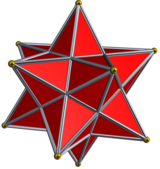 {5/2} |
 |5/2| |
| A regular starpentagon,{5/2}, has five vertices (its corner tips) and five intersecting edges, while a concavedecagon,|5/2|, has ten edges and two sets of five vertices. The first is used in definitions ofstar polyhedraand staruniform tilings,while the second is sometimes used in planar tilings. | |
 Small stellated dodecahedron |
 Tessellation |
Ingeometry,astar polygonis a type of non-convex polygon.Regular star polygonshave been studied in depth; while star polygons in general appear not to have been formally defined,certain notable onescan arise through truncation operations on regular simple or star polygons.
Branko Grünbaumidentified two primary usages of this terminology byJohannes Kepler,one corresponding to theregular star polygonswithintersecting edgesthat do not generate new vertices, and the other one to theisotoxalconcavesimple polygons.[1]
Polygramsinclude polygons like thepentagram,but also compound figures like thehexagram.
One definition of astar polygon,used inturtle graphics,is a polygon havingq≥ 2turns(qis called theturning numberordensity), like inspirolaterals.[2]
Names
editStar polygon names combine anumeral prefix,such aspenta-,with theGreeksuffix-gram(in this case generating the wordpentagram). The prefix is normally a Greekcardinal,but synonyms using other prefixes exist. For example, a nine-pointed polygon orenneagramis also known as anonagram,using theordinalnonafromLatin.[citation needed]The-gramsuffix derives fromγραμμή(grammḗ), meaning a line.[3]The namestar polygonreflects the resemblance of these shapes to thediffraction spikesof real stars.
Regular star polygon
edit{5/2} |
{7/2} |
{7/3} |
... |
Aregular star polygonis a self-intersecting, equilateral, and equiangularpolygon.
A regular star polygon is denoted by itsSchläfli symbol{p/q}, wherep(the number of vertices) andq(thedensity) arerelatively prime(they share no factors) and whereq≥ 2. The density of a polygon can also be called itsturning number:the sum of theturn anglesof all the vertices, divided by 360°.
Thesymmetry groupof {p/q} is thedihedral groupDp,of order 2p,independent ofq.
Regular star polygons were first studied systematically byThomas Bradwardine,and laterJohannes Kepler.[4]
Construction via vertex connection
editRegular star polygons can be created by connecting onevertexof a regularp-sided simple polygon to another vertex, non-adjacent to the first one, and continuing the process until the original vertex is reached again.[5]Alternatively, for integerspandq,it can be considered as being constructed by connecting everyqth point out ofppoints regularly spaced in a circular placement.[6]For instance, in a regular pentagon, a five-pointed star can be obtained by drawing a line from the 1st to the 3rd vertex, from the 3rd to the 5th vertex, from the 5th to the 2nd vertex, from the 2nd to the 4th vertex, and from the 4th to the 1st vertex.
Ifq≥p/2, then the construction of {p/q} will result in the same polygon as {p/(p−q)}; connecting every third vertex of the pentagon will yield an identical result to that of connecting every second vertex. However, the vertices will be reached in the opposite direction, which makes a difference when retrograde polygons are incorporated in higher-dimensional polytopes. For example, anantiprismformed from a prograde pentagram {5/2} results in apentagrammic antiprism;the analogous construction from a retrograde "crossed pentagram" {5/3} results in apentagrammic crossed-antiprism.Another example is thetetrahemihexahedron,which can be seen as a "crossed triangle" {3/2}cuploid.
Degenerate regular star polygons
editIfpandqare not coprime, a degenerate polygon will result with coinciding vertices and edges. For example, {6/2} will appear as a triangle, but can be labeled with two sets of vertices: 1-3 and 4-6. This should be seen not as two overlapping triangles, but as a double-winding single unicursal hexagon.[7][8]
Construction via stellation
editAlternatively, a regular star polygon can also be obtained as a sequence ofstellationsof a convex regularcorepolygon. Constructions based on stellation also allow regular polygonal compounds to be obtained in cases where the densityqand amountpof vertices are not coprime. When constructing star polygons from stellation, however, ifq>p/2, the lines will instead diverge infinitely, and ifq=p/2, the lines will be parallel, with both resulting in no further intersection in Euclidean space. However, it may be possible to construct some such polygons in spherical space, similarly to themonogonanddigon;such polygons do not yet appear to have been studied in detail.
Isotoxal star simple polygons
editWhen the intersecting line segments are removed from a regular starn-gon, the resulting figure is no longer regular, but can be seen as anisotoxalconcavesimple2n-gon, alternating vertices at two different radii.Branko Grünbaum,inTilings and patterns,represents such a star that matches the outline of a regularpolygram{n/d} as |n/d|, or more generally with {n𝛼}, which denotes anisotoxal concaveor convexsimple2n-gon with outerinternal angle𝛼.
- For |n/d|, the outer internal angle𝛼 = 180(1 − 2d/n)degrees, necessarily, and the inner (new) vertices have anexternal angleβext= 180[1 − 2(d− 1)/n]degrees, necessarily.
- For {n𝛼}, the outer internal and inner external angles, also denoted by 𝛼 andβext,do not have to match those of any regular polygram {n/d}; however,𝛼 < 180(1 − 2/n)degrees andβext< 180°,necessarily (here, {n𝛼} is concave).[1]
| |n/d| {n𝛼} |
|9/4| {920°} |
{330°} |
{630°} |
|5/2| {536°} |
{445°} |
|8/3| {845°} |
|6/2| {660°} |
{572°} |
|---|---|---|---|---|---|---|---|---|
| 𝛼 | 20° | 30° | 36° | 45° | 60° | 72° | ||
| βext | 60° | 150° | 90° | 108° | 135° | 90° | 120° | 144° |
| Isotoxal simple n-pointed star |
||||||||
| Related regular polygram {n/d} |
{9/4} |
{12/5} |
{5/2} |
{8/3} |
2{3} Star figure |
{10/3} | ||
Examples in tilings
editThese polygons are often seen in tiling patterns. The parametric angle 𝛼 (in degrees or radians) can be chosen to matchinternal anglesof neighboring polygons in a tessellation pattern. In his 1619 workHarmonices Mundi,among periodic tilings,Johannes Keplerincludes nonperiodic tilings, like that with three regular pentagons and one regular star pentagon fitting around certain vertices, 5.5.5.5/2, and related to modernPenrose tilings.[9]
| Isotoxal simple n-pointed stars |
"Triangular" stars (n= 3) |
"Square" stars (n= 4) |
"Hexagonal" stars (n= 6) |
"Octagonal" stars (n= 8) | ||
|---|---|---|---|---|---|---|
| Image of tiling | ||||||
| Vertex config. | 3.3* 𝛼.3.3** 𝛼 |
8.4* π/4.8.4* π/4 |
6.6* π/3.6.6* π/3 |
3.6* π/3.6** π/3 |
3.6.6* π/3.6 |
not edge-to-edge |
Interiors
editThe interior of a star polygon may be treated in different ways. Three such treatments are illustrated for a pentagram.Branko Grünbaumand Geoffrey Shephard consider two of them, as regular starn-gons and as isotoxal concave simple2n-gons.[9]
These three treatments are:
- Where a line segment occurs, one side is treated as outside and the other as inside. This is shown in the left hand illustration and commonly occurs in computervector graphicsrendering.
- The number of times that the polygonal curve winds around a given region determines itsdensity.The exterior is given a density of 0, and any region of density > 0 is treated as internal. This is shown in the central illustration and commonly occurs in the mathematical treatment ofpolyhedra.(However, for non-orientable polyhedra, density can only be considered modulo 2 and hence, in those cases, for consistency, the first treatment is sometimes used instead.)
- Wherever a line segment may be drawn between two sides, the region in which the line segment lies is treated as inside the figure. This is shown in the right hand illustration and commonly occurs when making a physical model.
When the area of the polygon is calculated, each of these approaches yields a different result.
In art and culture
editThis sectionneeds additional citations forverification.(March 2024) |
Star polygons feature prominently in art and culture. Such polygons may or may not beregular,but they are always highlysymmetrical.Examples include:
- The {5/2} star pentagon (pentagram) is also known as a pentalpha or pentangle, and historically has been considered by manymagicalandreligiouscults to haveoccultsignificance.
- The {7/2} and {7/3} star polygons (heptagrams) also have occult significance, particularly in theKabbalahand inWicca.
- The {8/3} star polygon (octagram) is a frequent geometrical motif inMughalIslamic artandarchitecture;the first is on theemblem of Azerbaijan.
- An eleven pointed star called thehendecagramwas used on thetomb of Shah Nematollah Vali.[11]
An {8/3}octagramconstructed in a regularoctagon |
Seal of Solomonwith circle and dots (star figure) |
See also
editReferences
edit- ^abGrünbaum & Shephard (1987). Tilings and Patterns. Section 2.5
- ^Abelson, Harold, diSessa, Andera, 1980,Turtle Geometry,MIT Press, p. 24
- ^γραμμή,Henry George Liddell, Robert Scott,A Greek-English Lexicon,on Perseus
- ^Coxeter, Introduction to Geometry, second edition, 2.8Star polygons,pp. 36–38
- ^Coxeter, Harold Scott Macdonald (1973).Regular polytopes.Courier Dover Publications. p.93.ISBN978-0-486-61480-9.
- ^Weisstein, Eric W."Star Polygon".MathWorld.
- ^Are Your Polyhedra the Same as My Polyhedra?Archived2016-08-03 at theWayback Machine,Branko Grünbaum
- ^Coxeter, The Densities of the Regular Polytopes I, p. 43:
Ifqis odd, the truncation of {p/q} is naturally {2p/q}. But ifqis even, the truncation of {p/q} consists of two coincident{p/(q/2)}'s;two, because each side arises once from an original side and once from an original vertex. Since2(q/2) =q,the density of a polygon is never altered by truncation. - ^abBranko Grunbaum and Geoffrey C. Shephard, Tilings by Regular Polygons, Mathematics Magazine #50 (1977), pp. 227–247, and #51 (1978), pp. 205–206
- ^Tiling with Regular Star Polygons,Joseph Myers
- ^Broug, Eric (2008-05-27).Islamic Geometric Patterns.London: Thames and Hudson. pp. 183–185, 193.ISBN978-0-500-28721-7.
- Cromwell, P.;Polyhedra,CUP, Hbk. 1997,ISBN0-521-66432-2.Pbk. 1999,ISBN0-521-66405-5.p. 175
- Grünbaum, B.and G. C. Shephard;Tilings and Patterns,New York: W. H. Freeman & Co. (1987),ISBN0-7167-1193-1.
- Grünbaum, B.;Polyhedra with Hollow Faces,Proc of NATO-ASI Conference on Polytopes... etc. (Toronto, 1993),ed. T. Bisztriczkyet al.,Kluwer Academic (1994), pp. 43–70.
- John H. Conway,Heidi Burgiel, Chaim Goodman-Strauss,The Symmetries of Things,2008,ISBN978-1-56881-220-5(Chapter 26, p. 404: Regular star-polytopes Dimension 2)
- Branko Grünbaum,Metamorphoses of polygons,published inThe Lighter Side of Mathematics: Proceedings of the Eugène Strens Memorial Conference on Recreational Mathematics and its History(1994)